
A "clean sweep" for a naval vessel is having "swept the enemy from the seas", a completely successful mission. It is traditionally indicated by hanging a broom from a mast or lashing it to the periscope of a submarine.

A "clean sweep" for a naval vessel is having "swept the enemy from the seas", a completely successful mission. It is traditionally indicated by hanging a broom from a mast or lashing it to the periscope of a submarine.
It is said the use of brooms in this respect originated during the 1650s, when the Dutch Admiral Maarten Tromp, after a decisive victory in the First Anglo-Dutch War, the Battle of Dungeness of 1652, hung a broom from his mast to indicate he had "swept the British from the seas" - his opponent Admiral Blake is said to have responded with the hoisting of a whip, indicating he would whip the Dutch into submission. However, both stories are legends; a broom in the seventeenth century indicated the ship was for sale. [1]
The United States Submarine Service during World War II generally considered a patrol a "clean sweep" if the sub sank every target she engaged. [2] Individual torpedoes might miss, and convoys usually had far too many ships for all to be sunk by a single boat, but these unavoidable inefficiencies did not mar a "clean sweep".
Few wide-ranging war patrols have been conducted since World War II, so commanding officers have taken other opportunities to fly brooms. For example, in the year 2000 the Military Sealift Command hung a broom from the flagpole yardarm outside their headquarters to symbolize its "clean sweep" of the Y2K bug on all the command's ships. [3]
In 2003, under circumstances perhaps closer to the traditional context, after USS Cheyenne and USS Pittsburgh (SSN-720) launched their Tomahawk missiles during Operation Iraqi Freedom, [4] her commanding officer decided that placing all missiles on target, with no duds or failures, was a modern "clean sweep".
For decades, brooms have been flown by warships that successfully pass all elements of their sea trials. Examples include USS Ohio in 2005 [5] and USS Virginia in 2006. [6]
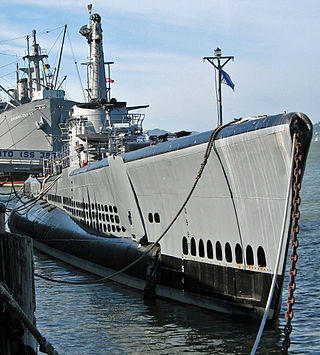
USS Pampanito (SS-383/AGSS-383), a Balao-class submarine, is a United States Navy ship, the third named for the pompano fish. She completed six war patrols from 1944 to 1945 and served as a United States Naval Reserve training ship from 1960 to 1971. She is now a National Historic Landmark, preserved as a memorial and museum ship in the San Francisco Maritime National Park Association located at Fisherman's Wharf in San Francisco, California.

USS George Washington (SSBN-598) was the United States's first operational ballistic missile submarine. She was the lead ship of her class of nuclear ballistic missile submarines, was the third United States Navy ship of the name, in honor of Founding Father George Washington (1732–1799), the first president of the United States, and was the first of that name to be purpose-built as a warship.
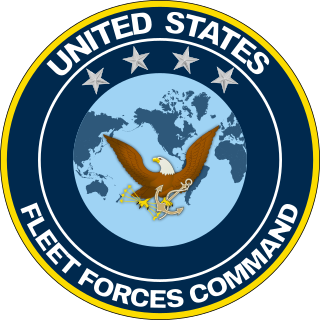
The United States Fleet Forces Command (USFF) is a service component command of the United States Navy that provides naval forces to a wide variety of U.S. forces. The naval resources may be allocated to Combatant Commanders such as United States Northern Command (USNORTHCOM) under the authority of the Secretary of Defense. Originally formed as United States Atlantic Fleet (USLANTFLT) in 1906, it has been an integral part of the defense of the United States of America since the early 20th century. In 2002, the Fleet comprised over 118,000 Navy and Marine Corps personnel serving on 186 ships and in 1,300 aircraft, with an area of responsibility ranging over most of the Atlantic Ocean from the North Pole to the South Pole, the Caribbean Sea, Gulf of Mexico, and the waters of the Pacific Ocean along the coasts of Central and South America.

The Seventh Fleet is a numbered fleet of the United States Navy. It is headquartered at U.S. Fleet Activities Yokosuka, in Yokosuka, Kanagawa Prefecture, Japan. It is part of the United States Pacific Fleet. At present, it is the largest of the forward-deployed U.S. fleets, with 50 to 70 ships, 150 aircraft and 27,000 Sailors and Marines. Its principal responsibilities are to provide joint command in natural disaster or military operations and operational command of all U.S. naval forces in the region.

USS Grayback (SS/SSG/APSS/LPSS-574), the lead ship of her class of submarine, was the second ship of the United States Navy to be named for the grayback.

USS Robalo (SS-273), a Gato-class submarine, was the only ship of the United States Navy to be named for the róbalo or common snook.

USS Cheyenne (SSN-773), the final Los Angeles-class submarine, is the third ship of the United States Navy to be named for Cheyenne, Wyoming. The contract to build her was awarded to Newport News Shipbuilding and Dry Dock Company in Newport News, Virginia on 28 November 1989 and her keel was laid down on 6 July 1992. She was launched on 16 April 1995 sponsored by Mrs. Ann Simpson, wife of Wyoming Senator Alan K. Simpson, and commissioned on 13 September 1996, with Commander Peter H. Ozimik in command. Cheyenne transferred to her homeport of Pearl Harbor, Hawaii, in 1998.

The commissioning pennant is a pennant flown from the masthead of a warship. The history of flying a commissioning pennant dates back to the days of chivalry with their trail pendants being flown from the mastheads of ships they commanded. Today, the commissioning pennants are hoisted on the day of commissioning and not struck until they are decommissioned. Some navies have a custom of flying a "paying off" or "decommissioning pennant," the length of which often reflects the length of service of the warship.

USS Maryland (SSBN-738) is an Ohio-class submarine in the United States Navy. Maryland is the 13th of the 18 Ohio-class ballistic missile submarines, and has been in active service since 1992. Maryland is the fourth US Navy vessel to be named after the US state of Maryland. Her mission is to provide the United States government with an undetectable and unattackable nuclear launch platform in support of the national strategy of strategic deterrence. The contract for the construction of the Maryland was awarded on 14 March 1986. Her keel was laid down by the Electric Boat Division of the General Dynamics Corporation at Groton, Connecticut, on 22 April 1986.
There are three major types of submarines in the United States Navy: ballistic missile submarines, attack submarines, and cruise missile submarines. All submarines currently in the U.S. Navy are nuclear-powered. Ballistic missile submarines have a single strategic mission of carrying nuclear submarine-launched ballistic missiles. Attack submarines have several tactical missions, including sinking ships and subs, launching cruise missiles, and gathering intelligence. Cruise missile submarines perform many of the same missions as attack submarines, but with a focus on their ability to carry and launch larger quantities of cruise missiles than typical attack submarines.

Rear Admiral Roy Milton Davenport was an American officer in the United States Navy. He is the first sailor to be awarded five Navy Crosses, the United States military's second highest decoration for valor. Davenport was awarded these military decorations while serving as a submarine commander in the Pacific during World War II.

Lawson Paterson "Red" Ramage was a vice admiral in the United States Navy and a noted submarine commander during World War II. Ramage was decorated with the Medal of Honor and several other combat decorations during the war. He also served during the Korean War and the Vietnam War.

Rear Admiral Rafael Celestino Benítez was a highly decorated American submarine commander who led the rescue effort of the crew members of the USS Cochino during the Cold War. After retiring from the navy, he was Pan American World Airways' vice president for Latin America. He taught international law for 16 years at the University of Miami School of Law, and served as associate dean, interim dean and director and founder of the foreign graduate law program. While there, he founded the comparative law LL.M. program, the inter-American law LL.M. program, and the Inter-American Law Review. After his death, the university established a scholarship in his memory to benefit a foreign attorney who is enrolled in one of the Law School's LL.M. programs.
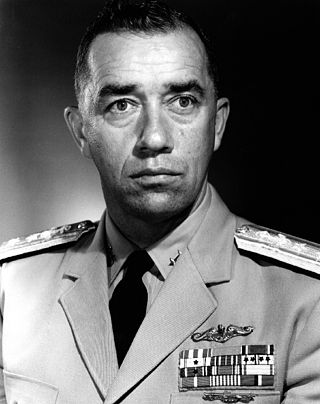
Eugene Parks "Dennis" Wilkinson was a United States Navy officer. He was selected for three historic command assignments. The first, in 1954, was as the first commanding officer of USS Nautilus, the world's first nuclear-powered submarine. The second was as the first commanding officer of USS Long Beach, America's first nuclear surface ship. The third was in 1980 when he was chosen as the first President and CEO of the Institute of Nuclear Power Operations (INPO) from which he retired in 1984.

Roy Stanley Benson, nicknamed "Ensign", was a veteran submarine commander in World War II who later served as the Commander Submarine Force U.S. Pacific Fleet (COMSUBPAC) during the Cold War.
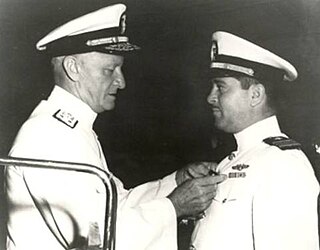
Thomas Burton Klakring was a United States Navy submarine commander during World War II.
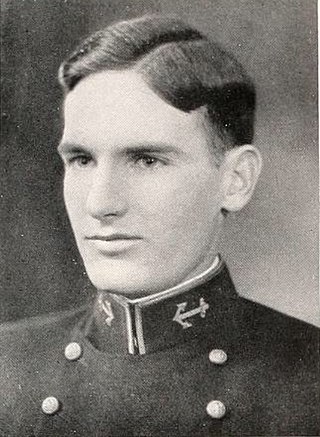
Charles Elliott Loughlin was an officer of the United States Navy, where he reached the rank of Rear Admiral. He is best known for his court-martial following the controversial sinking of the Japanese hospital ship Awa Maru. He was the commanding officer of the USS Queenfish (SS-393) during four war patrols. Loughlin earned two Navy Crosses, two Legions of Merit and one Silver Star during his time in the United States Navy.
Robert Edson "Dusty" Dornin was a United States Navy officer who served in the Pacific Theater of World War II as a very successful submarine commander. He remained in the Navy until his retirement in 1965.

The Jolly Roger is a symbol that has been used by submarines, primarily those of the Royal Navy Submarine Service and its predecessors. The practice came about during World War I: remembering comments by First Sea Lord Admiral Sir Arthur Wilson, who complained that submarines were "underhanded, unfair, and damned un-English" and that personnel should be hanged as pirates, Lieutenant Commander Max Horton began flying the flag after returning from successful patrols. Initially, Horton's submarine HMS E9 flew an additional flag after each successful patrol, but when there was no room for more, the practice was changed to a single large flag, onto which symbols indicating the submarine's achievements were sewn.
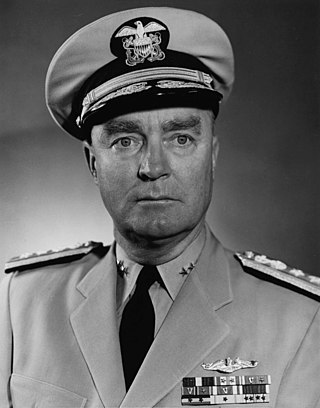
Norvell Gardiner Ward was an American naval officer and a recipient of the Navy Cross. He was a submariner for most of his naval career, but was also known for his planning and war gaming abilities. As a rear admiral he played a major role in planning and overseeing many naval operations during the Vietnam War, notably Operation Market Time.